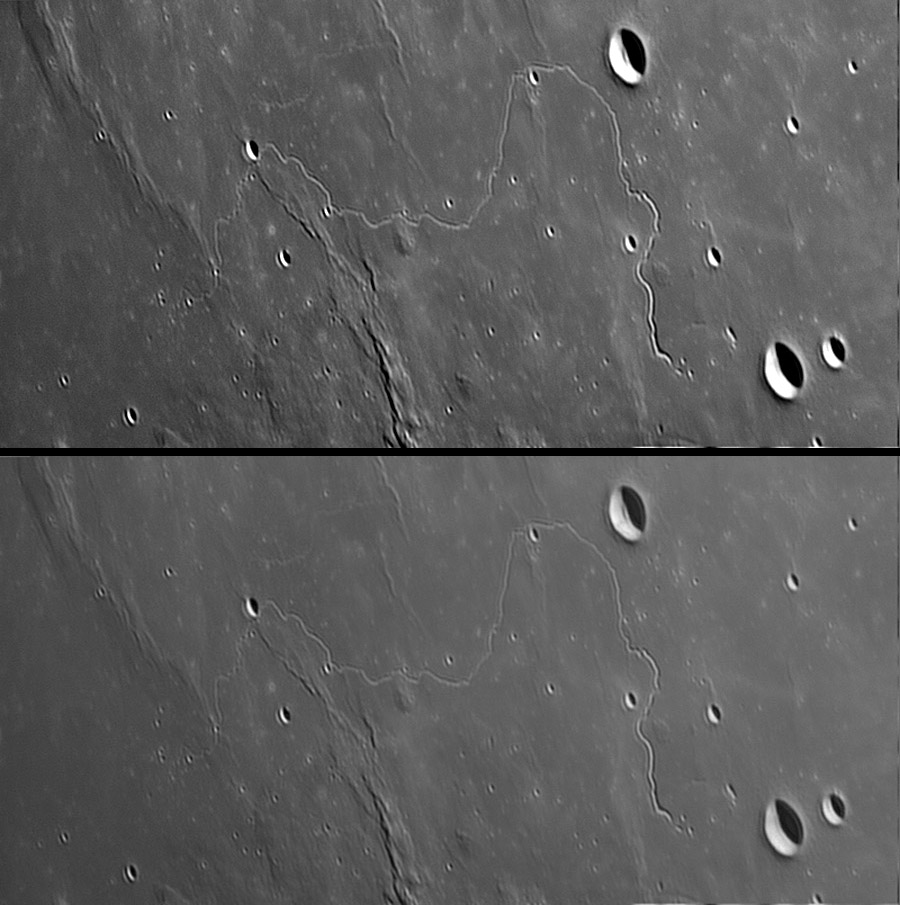Difference between revisions of "May 24, 2009"
(Created page with "__NOTOC__ =Tiny New Rille & Broad Mare Ridge= <!-- ws:start:WikiTextHeadingRule:2:<h1> --> <!-- ws:start:WikiTextLocalImageRule:8:<img src="/file/view/LPO...") |
|||
| Line 6: | Line 6: | ||
<em>image by [mailto:bayle.pascal2@wanadoo.fr Pascal Bayle], France. Original below, enhanced above.</em><br /> | <em>image by [mailto:bayle.pascal2@wanadoo.fr Pascal Bayle], France. Original below, enhanced above.</em><br /> | ||
<br /> | <br /> | ||
| − | Features that used to be nearly unknown a decade ago are now becoming familiar. The Marius Rille, a sinuous, long lava channel that seems languidly draped across southern Oceanus Procellarum is a case in point. Rükl gives a length of 250 km, with the width narrowing from 2 km near its starting position (right) to to 500 m at its end (left), where it is still visible in Pascal's image. This image also shows what appears to be a fainter rille near top-left that I don't remember noticing before. But looking back it is just visible on a Lunar Orbiter IV [http://the-moon.wikispaces.com/Rima+Marius image] and a previous view of the Marius Rille (which also includes [mailto:tychocrater@yahoo.com Chuck Wood]</em><br /> | + | Features that used to be nearly unknown a decade ago are now becoming familiar. The Marius Rille, a sinuous, long lava channel that seems languidly draped across southern Oceanus Procellarum is a case in point. Rükl gives a length of 250 km, with the width narrowing from 2 km near its starting position (right) to to 500 m at its end (left), where it is still visible in Pascal's image. This image also shows what appears to be a fainter rille near top-left that I don't remember noticing before. But looking back it is just visible on a Lunar Orbiter IV [http://the-moon.wikispaces.com/Rima+Marius image] and a previous view of the Marius Rille (which also includes [http://www.lpod.org/archive/archive/2004/06/LPOD-2004-06-07.htm nomenclature).] This short rille appears to be more tightly sinuous than the longer one. I keep having vague recollections that I must have seen it before - perhaps in Apollo images - but I can't find any view better than Pascal's. Another subtle thing to notice is the great width of the swell associated with the unnamed mare ridge at the upper left - see the sharp, but shallow change in slope just west of the crater Marius P?<br /> |
| + | <br /> | ||
| + | <em>[mailto:tychocrater@yahoo.com Chuck Wood]</em><br /> | ||
<br /> | <br /> | ||
<strong>Technical Details</strong><br /> | <strong>Technical Details</strong><br /> | ||
Revision as of 20:41, 1 January 2015
Tiny New Rille & Broad Mare Ridge

image by Pascal Bayle, France. Original below, enhanced above.
Features that used to be nearly unknown a decade ago are now becoming familiar. The Marius Rille, a sinuous, long lava channel that seems languidly draped across southern Oceanus Procellarum is a case in point. Rükl gives a length of 250 km, with the width narrowing from 2 km near its starting position (right) to to 500 m at its end (left), where it is still visible in Pascal's image. This image also shows what appears to be a fainter rille near top-left that I don't remember noticing before. But looking back it is just visible on a Lunar Orbiter IV image and a previous view of the Marius Rille (which also includes nomenclature). This short rille appears to be more tightly sinuous than the longer one. I keep having vague recollections that I must have seen it before - perhaps in Apollo images - but I can't find any view better than Pascal's. Another subtle thing to notice is the great width of the swell associated with the unnamed mare ridge at the upper left - see the sharp, but shallow change in slope just west of the crater Marius P?
Chuck Wood
Technical Details
8 Jan 2009 at 20:54:31 ut. 14" scope + DMK 21AF04 + POWERMATE x2.5
Related Links
Rükl plate 18
COMMENTS?
Click on this icon File:PostIcon.jpg at the upper right to post a comment.



